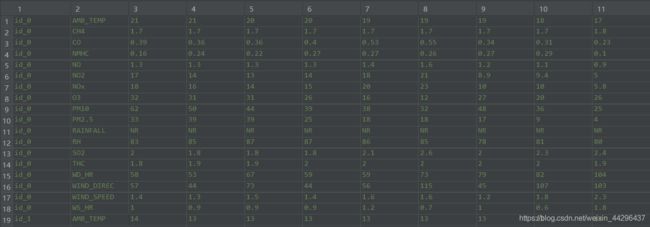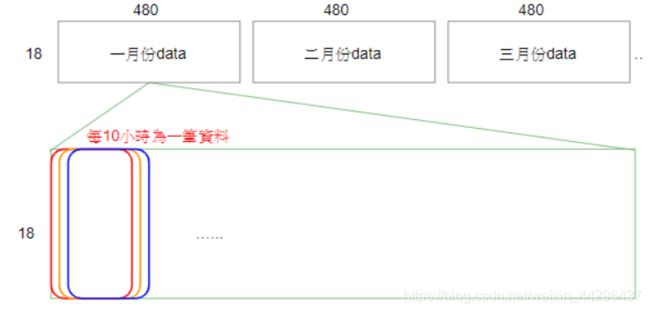李宏毅机器学习2020HW1——手推线性回归公式预测PM2.5
前言
这个是课程第一个作业,用线性回归模型做PM2.5的预测,优化方法用Adagrad,李老师提供了训练集和测试集以及示例代码,并推荐使用Linux或者Mac系统来做作业。而我准备用win10系统来完成这项作业。
一、要求
给定训练集train.csv和测试集test.csv,要求根据前9个小时的空气监测情况预测第10个小时的PM2.5含量。
二、环境
Win10系统,使用Pycharm,Python3.7。
三、数据介绍
首先熟悉一下数据,训练集train.csv包含每个月前20天的完整观测数据,因为数据的编码方式是big5,使用Pycharm打开文件后显示乱码,先选择文件编码方式为“Big5-HKSCS”,reload之后就能正常打开。
训练集包含2014年1-12月中每个月前20天的数据,每个小时均记录一次数据,每次记录18个特征数据,包括AMB_TEMP, CH4, CO, NHMC, NO, NO2, NOx, O3, PM10, PM2.5, RAINFALL, RH, SO2, THC, WD_HR, WIND_DIREC, WIND_SPEED, WS_HR。其中RAINFALL指标的值不是数值格式。总共有4230行、24列有效数据(4320 = 12个月20天18个特征),部分训练集数据如下图。
 测试集test.csv的格式与训练集类似,共有240个id(类似训练集的240个日期),每个id有18项特征,均有9个小时的数据,以此来预测第10小时的PM2.5。总共有240行、9列有效数据。部分测试集数据如下图所示。
测试集test.csv的格式与训练集类似,共有240个id(类似训练集的240个日期),每个id有18项特征,均有9个小时的数据,以此来预测第10小时的PM2.5。总共有240行、9列有效数据。部分测试集数据如下图所示。

四、训练集数据预处理
在Pycharm中新建一个Python工程,在venv文件夹中新建文件夹data,将train.csv和test.csv放入其中。
1. 数据清洗
训练集中前三列不是数值部分,因此要从第四列开始取值,且需要将RAINFALL行的内容‘NR’替换为数值(以0代替)。
import pandas as pd
import numpy as np
data = pd.read_csv('./data/train.csv', encoding='Big5')
data = data.iloc[:, 3:] #iloc是根据行列号来取数据
data[data == 'NR'] = 0 #将RAINFALL行的字符替换为0
raw_data = data.to_numpy() #转换为numpy数组
清洗完后,raw_data大小为4320*24。
2. 提取特征
按月份来看,清洗后的数据(raw_data)是可看成由12份360*24的二维数组组成(360 = 20天*18个特征)。将每份360*24的数组转换成18*480的数组,如下图所示。

转换后的数组将变成如下形式:

将12组18*480数组以放入一个字典中。
month_data = {
}
for month in range(12):
sample = np.empty([18, 480]) #空的18*480数组
for day in range(20):
sample[:, day*24:(day+1)*24] = raw_data[18*(day+20*month):18*(day+1+20*month), :]
month_data[month] = sample
由于最终目的是根据前9小时的数据预测第10小时的PM2.5,所以要把10小时的数据分为一组,其中前9小时的18*9个特征作为输入x,第10个小时的第10个特征作为输出y。上述转换后的18*480数组中,480列依次为同一个月1号到20号各小时的数据,也就是480个小时的数据。以1月份的数据为例,1-10列是1-10小时的数据,作为第1组数据;2-11列是2-10小时的数据,作为第2组数据;以步长为1的方式取值到第480列为止。如下图所示。

这样,一个月就有471组数据,12个月就有12*471组数据,每组数据中,前9小时的数据(18*9的数组)转换成18*9维行向量作为输出;将第10小时的数据(18维列向量)中的第10行的数据(即第10个特征PM2.5的值)作为输出。12个月的12*471组数据的输出放入总的输入x中(12*471行,18*9列的数组),同理输出y为12*471维列向量。
reshape(1, -1):转换成一个行向量
x = np.empty([12*471, 18*9], dtype=float)
y = np.empty([12*471, 1], dtype=float)
for month in range(12):
for day in range(20):
for hour in range(24):
if hour > 14 and day == 19:
continue
x[month*471 + day*24 + hour, :] = month_data[month][:, day*20 + hour:day*20 + hour + 9].reshape(1, -1)
y[month*471 + day*24 + hour, :] = month_data[month][9, day*20 + hour + 9]
3. 标准化
方法是减去列均值再除以列标准差。
np.mean():求均值。axis = 0:压缩行,对各列求均值,返回 1* n 矩阵。
np.std():求标准差。axis=0:计算每一列的标准差。
mean_x = np.mean(x, axis = 0) #18 * 9
std_x = np.std(x, axis = 0) #18 * 9
for i in range(len(x)): #12 * 471
for j in range(len(x[0])): #18 * 9
if std_x[j] != 0:
x[i][j] = (x[i][j] - mean_x[j]) / std_x[j]
#print(x)
六、训练
模型:线性回归
y = [ y 1 y 2 ⋮ y m ] = [ b + w 1 x 1 , 1 + w 2 x 1 , 2 + . . . + w n x 1 , n b + w 1 x 2 , 1 + w 2 x 2 , 2 + . . . + w n x 2 , n ⋮ b + w 1 x m , 1 + w 2 x m , 2 + . . . + w n x m , n ] = [ 1 x 1 , 1 x 1 , 2 ⋯ x 1 , n 1 x 2 , 1 x 2 , 2 ⋯ x 2 , n ⋮ ⋮ ⋮ ⋱ ⋮ 1 x m , 1 x m , 2 ⋯ x m , n ] [ b w 1 w 2 ⋮ w n ] = [ x 1 x 2 ⋮ x m ] w = X w n = 18 ∗ 9 , m = 12 ∗ 471 \mathbf{y}=\left[\begin{matrix}y_1\\y_2\\\vdots\\y_{m}\end{matrix}\right]=\left[\begin{matrix}b+w_{1}x_{1,1}+w_{2}x_{1,2}+...+w_{n}x_{1,n}\\b+w_{1}x_{2,1}+w_{2}x_{2,2}+...+w_{n}x_{2,n}\\\vdots\\b+w_{1}x_{m,1}+w_{2}x_{m,2}+...+w_{n}x_{m,n}\end{matrix}\right]\\=\left[\begin{matrix}1&x_{1,1}&x_{1,2}&\cdots&x_{1,n}\\1&x_{2,1}&x_{2,2}&\cdots&x_{2,n}\\\vdots&\vdots&\vdots&\ddots&\vdots\\1&x_{m,1}&x_{m,2}&\cdots&x_{m,n}\end{matrix}\right]\left[\begin{matrix}b\\w_1\\w_2\\\vdots\\w_n\end{matrix}\right]=\left[\begin{matrix}\mathbf{x}_1\\\mathbf{x}_2\\\vdots\\\mathbf{x}_m\end{matrix}\right]\mathbf{w}=\mathbf{X}\mathbf{w}\\n=18*9,m=12*471 y=⎣⎢⎢⎢⎡y1y2⋮ym⎦⎥⎥⎥⎤=⎣⎢⎢⎢⎡b+w1x1,1+w2x1,2+...+wnx1,nb+w1x2,1+w2x2,2+...+wnx2,n⋮b+w1xm,1+w2xm,2+...+wnxm,n⎦⎥⎥⎥⎤=⎣⎢⎢⎢⎡11⋮1x1,1x2,1⋮xm,1x1,2x2,2⋮xm,2⋯⋯⋱⋯x1,nx2,n⋮xm,n⎦⎥⎥⎥⎤⎣⎢⎢⎢⎢⎢⎡bw1w2⋮wn⎦⎥⎥⎥⎥⎥⎤=⎣⎢⎢⎢⎡x1x2⋮xm⎦⎥⎥⎥⎤w=Xwn=18∗9,m=12∗471
损失函数:均方根误差
L ( w ) = 1 m ∑ i = 1 m ( y i − y ^ i ) 2 = 1 m ∑ i = 1 m ( x i w − y ^ i ) 2 , m = 12 ∗ 471 L(\mathbf{w})=\sqrt{\frac{1}{m}\sum_{i=1}^m(y_i-\hat{y}_i)^2}=\sqrt{\frac{1}{m}\sum_{i=1}^m(\mathbf{x}_i\mathbf{w}-\hat{y}_i)^2},m=12*471 L(w)=m1i=1∑m(yi−y^i)2=m1i=1∑m(xiw−y^i)2,m=12∗471
优化方法:Adagrad
w t + 1 = w t − η t σ t ∂ L ( w t ) ∂ w t \mathbf{w}^{t+1}=\mathbf{w}^t-\frac{\eta^t}{\sigma^t}\frac{\partial{L(\mathbf{w}^t)}}{\partial\mathbf{w}^t} wt+1=wt−σtηt∂wt∂L(wt)
σ t = 1 t + 1 ∑ i = 0 t ( ∂ L ( w i ) ∂ w i ) 2 \sigma^t=\sqrt{\frac{1}{t+1}\sum_{i=0}^t\left(\frac{\partial{L(\mathbf{w}^i)}}{\partial\mathbf{w}^i}\right)^2} σt=t+11i=0∑t(∂wi∂L(wi))2
η t = η t + 1 \eta^t=\frac{\eta}{\sqrt{t+1}} ηt=t+1η
化简后可得Adagrad的优化公式:
w t + 1 = w t − η ∑ i = 0 t ( ∂ L ( w i ) ∂ w i ) 2 ∂ L ( w t ) ∂ w t \mathbf{w}^{t+1}=\mathbf{w}^t-\frac{\eta}{\sqrt{\sum_{i=0}^t\left(\frac{\partial{L(\mathbf{w}^i)}}{\partial\mathbf{w}^i}\right)^2}}\frac{\partial{L(\mathbf{w}^t)}}{\partial \mathbf{w}^t} wt+1=wt−∑i=0t(∂wi∂L(wi))2η∂wt∂L(wt)
为减少梯度 ∂ L ( w t ) ∂ w t \frac{\partial{L(\mathbf{w}^t)}}{\partial \mathbf{w}^t} ∂wt∂L(wt)的计算量,将 L ( w ) L(\mathbf{w}) L(w)简化为 L o s s = ∑ i = 1 m ( x i w − y ^ i ) 2 Loss=\sum_{i=1}^m(\mathbf{x}_i\mathbf{w}-\hat{y}_i)^2 Loss=∑i=1m(xiw−y^i)2来求梯度,其中, ( x i w − y ^ i ) 2 = ( b + x i , 1 w 1 + x i , 2 w 2 + ⋯ + x i , n w n ) 2 (\mathbf{x}_i\mathbf{w}-\hat{y}_i)^2=(b+x_{i,1}w_1+x_{i,2}w_2+\cdots+x_{i,n}w_n)^2 (xiw−y^i)2=(b+xi,1w1+xi,2w2+⋯+xi,nwn)2。即: ∂ L ( w t ) ∂ w t = [ ∂ L ( w t ) ∂ b t ∂ L ( w t ) ∂ w 1 t ⋮ ∂ L ( w t ) ∂ w n t ] = 2 [ 1 ( x 1 w − y ^ 1 ) + 1 ( x 2 w − y ^ 2 ) + ⋯ + 1 ( x m w − y ^ m ) x 1 , 1 ( x 1 w − y ^ 1 ) + x 2 , 1 ( x 2 w − y ^ 2 ) + ⋯ + x m , 1 ( x m w − y ^ m ) ⋮ x 1 , n ( x 1 w − y ^ 1 ) + x 2 , n ( x 2 w − y ^ 2 ) + ⋯ + x m , n ( x m w − y ^ m ) ] = 2 [ 1 1 ⋯ 1 x 1 , 1 x 2 , 1 ⋯ x m , 1 x 1 , 2 x 2 , 2 ⋯ x m , 2 ⋮ ⋮ ⋱ ⋮ x 1 , n x 2 , n ⋯ x m , n ] ( [ x 1 w x 2 w ⋮ x m w ] − [ y ^ 1 y ^ 2 ⋮ y ^ m ] ) = 2 X T ( X w − y ^ ) \frac{\partial{L(\mathbf{w}^t)}}{\partial \mathbf{w}^t}=\left[\begin{matrix}\frac{\partial{L(\mathbf{w}^t)}}{\partial b^t}\\\frac{\partial{L(\mathbf{w}^t)}}{\partial w_1^t}\\\vdots\\\frac{\partial{L(\mathbf{w}^t)}}{\partial w_n^t}\end{matrix}\right]=2\left[\begin{matrix}1(\mathbf{x}_1\mathbf{w}-\hat{y}_1)+1(\mathbf{x}_2\mathbf{w}-\hat{y}_2)+\cdots+1(\mathbf{x}_m\mathbf{w}-\hat{y}_m)\\x_{1,1}(\mathbf{x}_1\mathbf{w}-\hat{y}_1)+x_{2,1}(\mathbf{x}_2\mathbf{w}-\hat{y}_2)+\cdots+x_{m,1}(\mathbf{x}_m\mathbf{w}-\hat{y}_m)\\\vdots\\x_{1,n}(\mathbf{x}_1\mathbf{w}-\hat{y}_1)+x_{2,n}(\mathbf{x}_2\mathbf{w}-\hat{y}_2)+\cdots+x_{m,n}(\mathbf{x}_m\mathbf{w}-\hat{y}_m)\end{matrix}\right]\\=2\left[\begin{matrix}1&1&\cdots&1\\x_{1,1}&x_{2,1}&\cdots&x_{m,1}\\x_{1,2}&x_{2,2}&\cdots&x_{m,2}\\\vdots&\vdots&\ddots&\vdots\\x_{1,n}&x_{2,n}&\cdots&x_{m,n}\end{matrix}\right]\left(\left[\begin{matrix}\mathbf{x}_1\mathbf{w}\\\mathbf{x}_2\mathbf{w}\\\vdots\\\mathbf{x}_m\mathbf{w}\end{matrix}\right]-\left[\begin{matrix}\hat{y}_1\\\hat{y}_2\\\vdots\\\hat{y}_m\end{matrix}\right]\right)=2\mathbf{X}^T\left(\mathbf{X}\mathbf{w}-\mathbf{\hat{y}}\right) ∂wt∂L(wt)=⎣⎢⎢⎢⎢⎢⎡∂bt∂L(wt)∂w1t∂L(wt)⋮∂wnt∂L(wt)⎦⎥⎥⎥⎥⎥⎤=2⎣⎢⎢⎢⎡1(x1w−y^1)+1(x2w−y^2)+⋯+1(xmw−y^m)x1,1(x1w−y^1)+x2,1(x2w−y^2)+⋯+xm,1(xmw−y^m)⋮x1,n(x1w−y^1)+x2,n(x2w−y^2)+⋯+xm,n(xmw−y^m)⎦⎥⎥⎥⎤=2⎣⎢⎢⎢⎢⎢⎡1x1,1x1,2⋮x1,n1x2,1x2,2⋮x2,n⋯⋯⋯⋱⋯1xm,1xm,2⋮xm,n⎦⎥⎥⎥⎥⎥⎤⎝⎜⎜⎜⎛⎣⎢⎢⎢⎡x1wx2w⋮xmw⎦⎥⎥⎥⎤−⎣⎢⎢⎢⎡y^1y^2⋮y^m⎦⎥⎥⎥⎤⎠⎟⎟⎟⎞=2XT(Xw−y^)
np.zeros([m,n]):返回一个全0的m*n数组。
np.ones([m,n]):返回一个全1的m*n维数组。
np.concatenate((a,b),axis=1):a和b做行拼接,结果为[a,b]。
np.dot(x,w):x和w点乘。
np.power(x,n):x中各元素的n次方。
np.sqrt(x):x中各元素的平方根。
np.sum(x):x中所有元素的和,返回一个值。
x.transpose():将x转置。
dim = 18 * 9 + 1 #参数:18*9个权重 + 1个偏置bias
w = np.zeros([dim, 1]) #参数列向量初始化为0
#x新增一列用来与偏置bias相乘,将模型y=wx+b转化成y=[b,w]转置·[1,x]
x = np.concatenate((np.ones([12 * 471, 1]), x), axis = 1).astype(float)
learning_rate = 1
iter_time = 1000
adagrad = np.zeros([dim, 1])
eps = 0.0000000001
for t in range(iter_time):
loss = np.sqrt(np.sum(np.power(np.dot(x, w) - y, 2))/471/12)#rmse
if(t%100==0):
print(str(t) + ":" + str(loss))
gradient = 2 * np.dot(x.transpose(), np.dot(x, w) - y) #dim*1
adagrad += gradient ** 2
w = w - learning_rate * gradient / np.sqrt(adagrad + eps) #eps是一个很小的正数,避免分母为0
np.save('weight.npy', w)
#print(w)
七、测试
测试集数据与训练集类似,不过只给了9个小时的数据,第10小时的数据需要用训练的模型预测。总共有240个id的数据,也就是240组18*9的数据,需要预测出240个值。
1. 数据预处理
首先,测试集需要数据预处理,过程类似于对训练集做预处理。有一点需要注意,测试集的第一行就是数据,而pd.read_csv()在读取数据时,默认把第一行看作列号(非数据),因此在使用该函数时,要添加参数设置:header=None。
testdata = pd.read_csv('./data/test.csv', header=None, encoding='Big5')
test_data = testdata.iloc[:, 2:]
test_data[test_data == 'NR'] = 0
test_data = test_data.to_numpy()
test_x = np.empty([240, 18*9], dtype=float)
for i in range(240):
test_x[i, :] = test_data[18*i: 18*(i + 1), :].reshape(1, -1)
std_test_x = np.std(test_x, axis=0)
mean_test_x = np.mean(test_x, axis=0)
for i in range(len(test_x)):
for j in range(len(test_x[0])):
if std_test_x[j] != 0:
test_x[i][j] = (test_x[i][j] - mean_test_x[j]) / std_test_x[j]
test_x = np.concatenate((np.ones([240, 1]), test_x), axis = 1).astype(float)
#print(test_x)
2. 预测
最后进行预测,将结果为负数的项替换为0。
w = np.load('weight.npy')
ans_y = np.dot(test_x, w)
for i in range(240):
if(ans_y[i]<0):
y[i] = 0
#print(ans_y)
将结果保存到csv文件中。
import csv
with open('submit.csv', mode='w', newline='') as submit_file:
csv_writer = csv.writer(submit_file)
header = ['id', 'value']
print(header)
csv_writer.writerow(header)
for i in range(240):
row = ['id_' + str(i), ans_y[i][0]]
csv_writer.writerow(row)
print(row)